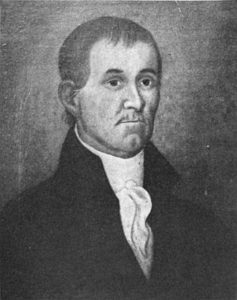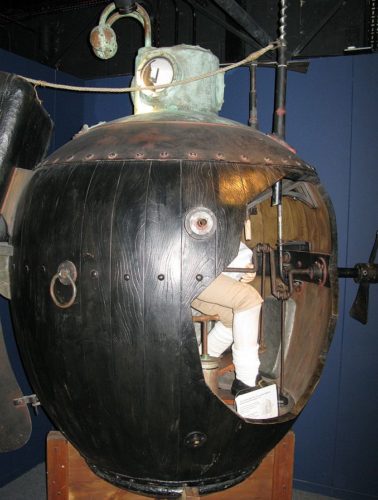There was a time before our time,
It will not come again,
When the best ships still were wooden ships
But the men were iron men …

I believe this eloquent verse from Rosemary and Stephen Vincent Benet’s ode to New England’s “Clipper Ships and Captains” can also be used to describe Ezra Lee, the first man to command an attack submarine in battle.
In this essay, I will describe the heroism of this native of Lyme, Conn., and present some key elements of this remarkable period in Connecticut’s history. However, I think that one must have some understanding of his primitive submarine in order to fully appreciate Ezra Lee’s courage.
Bushnell’s Genius
This first submarine, named the Turtle, was designed and built by David Bushnell in what is now Westbrook, Conn.
Bushnell was a farmer, but left the family farm in the care of his brother, Ezra, in 1771 to pursue his education at Yale College. He graduated in 1775. His last year at Yale coincided with the Battles of Lexington and Concord, i.e., the beginning of the American War of Independence.
By that time, several other important events leading to the war with the British had already occurred. They included the Boston Massacre (1770), the Boston Tea Party (1773); and enactment of the Boston Port Act, which was one of five “Intolerable Acts”, implemented in 1774 to punish the colonists after the Tea Party. The law, was enforced by a British naval blockade of Boston harbor, which effectively shut down all commerce and travel in and out of Boston and the Massachusetts colony.
Bushnell was a fervent patriot and felt strongly that defeating the mighty British Navy would require unconventional tactics. He began a collaboration with another member of the Yale community, Phineas Pratt. One of their first projects was the development of an underwater bomb with a mechanical time-delayed detonator – a distant forerunner of contemporary naval mines. It is noteworthy that part of his Yale tenure overlapped with Nathan Hale’s, who graduated in 1773.
Bushnell felt that he could use this underwater explosive against the British if he could develop the means to deliver it to a targeted warship and place it below the waterline.
So, having returned to Westbrook after graduation, Bushnell’s small team, which now included his brother Ezra, turned its attention to developing a vessel that could transport and attach these explosive devices to enemy warships … and the idea of a “sub-marine” was conceived. Bushnell recognized that, to be effective and avoid detection, the vessel would have to be completely submerged for some period of time during the mission; be able to move through the water; and, when ready, return safely to the surface.
Colonial Era Engineering Limitations
With little real successful precedent on which to build, Bushnell’s submarine would be a “true” invention. Clearly, there were many significant engineering and design problems that the team had to resolve. They included building a watertight, pressure-proof, and vertically stable vessel; propulsion – both vertical and horizontal; steering, and vision; and the actual weapons-delivery system.
A key issue was that of developing the means to vary the vessel’s ballast in order to enable submersion and re-surfacing. Bushnell eventually solved these problems and introduced some innovations. For example, he equipped his vessel with an early snorkel-type breathing device and a two-bladed propeller for propulsion.
The Turtle

I realize that I am over-simplifying here, but I’m trying to avoid getting stuck in the sea-weeds of the Turtle’s design and construction.
The Turtle resembled two tortoise shells, bound together. It was constructed of oak timbers, which were shaped, joined, and caulked at the joints. The vessel was bound with iron bands and covered with tar to ensure water tightness.
It was about 7 ft. long, 4 ft. wide, and 8 ft. from its keel to the top of its brass “conning tower,” which protruded about eight inches out of the water. It had no periscope, but the conning tower contained six glass ports.
The submarine was capable of only carrying one person, who sat upright on a seat roughly resembling a bicycle seat (see photo at left.) Moreover, Turtle was equipped with a depth gauge to measure distance from the surface. a compass for navigating, and a crude ventilator to supply the vessel with fresh air at the surface.
Controls included hand-cranks and pedals for operation of the propellers; a rudder, located behind the operator, controlled by foot; and; an “immersion chamber,” for flooding when additional ballast was required. Turtle submerged and surfaced via brass pumps that took in or expelled seawater as ballast, and 700 pounds of lead weights, which could be let out or retracted as needed.
The Turtle had no real ballast tanks; and the incoming seawater simply flooded the floor of the cabin – leaving the operator knee-deep in water until it was eliminated with the pumps when it was time to surface.
Two tubes, which passed through the conning tower hatch provided fresh air when near the surface. The air supply would last only about 30 minutes, and would soon become foul when the submarine was submerged. The exterior was equipped with a large screw that could be twisted into the planks of a ship’s hull. The screw was tethered by a rope to one of Bushnell’s timed explosive devices.
It is interesting that Bushnell had actually consulted fellow revolutionary, Ben Franklin, to solve the problem of illuminating the Turtle’s interior – who suggested using phosphorescent “foxfire.”
Sea Trials
Turtle was tested after completion of construction in 1775 in the relative safety of the Connecticut River. Ben Franklin observed the initial tests from the shore and was favorably impressed and understood its potential in naval warfare. The Turtle was also recommended to George Washington by Connecticut Governor Jonathan Trumbull. Ezra Bushnell had been trained in operating the Turtle and had assumed that role during testing, and presumably, would also pilot the vessel in battle.
As noted, the Turtle held only a single person, and that person was wholly responsible for bringing the craft to the target and attaching and arming the explosives. That person required substantial physical strength and stamina, incredible focus, and the utter absence of claustrophobia.
There are replicas of the Turtle in Groton’s Submarine Force Museum and the CT River Museum in Essex; which has a cut-away display in which one may experience Turtle’s cabin.
The Bushnell Farm house is located at 1445 Boston Post Rd., Old Saybrook, CT.
The First Mission
The Turtle was ready for deployment by the spring of 1776 – and may have originally been planned for use against the British warships blockading Boston Harbor. However, by that time, the British had ended their blockade and moved their ships north to Halifax, Nova Scotia.
Ezra Lee’s Mission
In July, 1776, a British naval force began to move into New York Harbor, carrying supplies and soldiers. General William Howe and Admiral Richard Howe had essentially shut down western Long Island and New York to the colonists.
The Turtle was transported overland through Connecticut to New York Harbor, which was still in American hands. After arriving in New York, Ezra Bushnell developed a terrible fever, possibly Typhoid, and was unable to carry out any mission.
Brigadier General Samuel Holden Parsons, also from Lyme, then recommended three men to train to pilot the submarine. One of those men was his brother-in-law, Ezra Lee. So, to avoid discovery by the British, David Bushnell returned to Connecticut with the Turtle, and began intensive training of the three recruits. After a month of training, Lee was chosen to make the first attack on a British warship.
General Washington gave permission for Turtle’s first mission on Sept. 6 – an attack on the HMS Eagle, Admiral Howe’s flagship, which was anchored in New York Harbor, south of Manhattan. Near midnight on the 6th, Turtle was towed by a pulling boat from the Battery towards the Eagle. Halfway, Ezra Lee entered the Turtle and secured the hatch over his head. – and a submarine was engaged in battle for the first time against an enemy ship. Later, Lee wrote several letters describing this mission.
It took Lee nearly two hours of pedaling to reach the Eagle. Once there, he took on some ballast, and submerged completely. When he thought he was under his target, he pumped out a small quantity of water from the ballast tank, until a bump indicated he was beneath Eagle, with the auger screw against the ship’s bottom.
Unfortunately, Lee’s attempt to attach the explosive with the auger screw failed, possibly because a metal plate covered the area where he was trying to drill. He was forced to re-surface to replenish his air supply. He submerged again and attempted to drill into another spot in the hull. On that second dive he was unable to stay beneath the ship, and eventually abandoned the attempt.
It is possible that the tide turned during the second attack and Lee was unable to compensate. Lee’s mission was near the southern tip of Manhattan, where the Hudson River and the East River merge. The currents tend to be strong and complex there. So, Turtle would only be able to attack a ship moored in that area during a short period of time when the incoming tide balanced the river currents.
Lee was exhausted, and the outgoing tide threatened to take Turtleout to sea. He ejected all the ballast water and began pedaling with his remaining strength. With the ballast water pumped out, one third of Turtle’s hull stuck out of the water, making it clearly visible in daylight. As the day grew lighter, the British spotted the Turtle, and set out in small boats to confront it.
To divert the patrol and to lighten his craft, Lee released the explosive device that he had tried to attach to Eagle. It drifted towards the East River and soon exploded. In Lee’s words, it, “went off with a tremendous explosion, throwing up large bodies of water to an immense height.” Lee returned safely after several hours on the water and received Washington’s congratulations in person.
Lee did make a second unsuccessful attempt against the British frigate HMS Cereberus, but was discovered and forced to retreat.
An Ignominious Victory
Although Turtle’s missions were unsuccessful in that no damage was inflicted on any British vessel, some historians feel that the venture was, by no means, a failure. They suggest that the explosion led to Admiral Howe ordering the British warships to be repositioned further off the harbor, from which they could no longer maintain their blockade of New York.
Perhaps an intangible psychological victory might also be claimed simply through her use as another unconventional weapon of war employed by the colonists. These also included the guerilla tactics employed by the self-trained and highly mobile militia, which was organized to assemble rapidly and deploy where needed, and aptly named the “Minutemen.”
Note that the National Archives possess a letter that George Washington wrote to Thomas Jefferson in September,1785 about the Turtle, saying, “I then thought, and still think, that it was an effort of genius.”
David Bushnell – After the Attack on Eagle
Bushnell loaded Turtle aboard a fast sloop, hoping that the sloop could slip unnoticed past the British into Long Island Sound and back to Connecticut. A British frigate discovered the sloop, however, and, according to the British, sank her and her cargo. Note that there are many versions of the Turtle’s final days.
In 1778, General Washington proposed the formation of a new military unit to be known as the “Corps of Sappers and Miners” (i.e., combat engineers.) It was organized in the summer of the next year. Bushnell was given command of the Corps with the rank of captain-lieutenant in August, 1779.
Ezra Lee – After the Attack on Eagle
Lee was moved by Washington into the secret service/special forces. He later participated in the Battles of Trenton, Brandywine and Monmouth.
Lee died in 1821. His obituary in the “Commercial Advisor” (November 1821) stated: “Died, at Lyme, on the 29th October Captain Ezra Lee, aged 72, a revolutionary officer. He died without an enemy. It is not a little remarkable, that this officer is the only man, of which it can be said, that he fought the enemy upon land–upon water–and under the water…”
Lee is buried in the Duck River Cemetery in Old Lyme. The inscription on his original grave marker was: “EZRA LEE. / DIED / Aged 72 Years. / He was a Revolutionary / Officer, / and esteemed by / Washington.” Unfortunately, during the colonial era, gravestones were often made from softer types of stone, such as sandstone and slate, which were easier to cut and carve. However, they deteriorated. Lee’s original marker has been replaced with a granite obelisk, but without the full original inscription.
Some Observations by the Author
I am not a native of southeast Connecticut. Rather. I am an émigré from West Simsbury in Connecticut’s northwest hills. I knew almost nothing about David Bushnell and Ezra Lee before visiting the Connecticut River Museum, but I was encouraged to learn more.
Stewart Holbrook, author of “Lost Men of American History,” has claimed that “… had a Longfellow fastened upon him, Ezra Lee would be as well known today as Paul Revere, and it is a pity that he isn’t.”
“Bushnell’s Infernal Machine” sung by New England balladeer Larry Kaplan
This song provides a view of Turtle from the inside. Kaplan is known for his songs of New England and its seas. Visit this link to see the song performed.
Editor’s Note: The author is going a few miles north on the Connecticut River for his next essay to visit William Gillette and review his impact on the cinematic portrayal of Sherlock Holmes.

About the author: Tom Gotowka’s entire adult career has been in healthcare. He’ will sit on the Navy side at the Army/Navy football game. He always sit on the crimson side at any Harvard/Yale contest. He enjoys reading historic speeches and considers himself a scholar of the period from FDR through JFK.
A child of AM Radio, he probably knows the lyrics of every rock and roll or folk song published since 1960. He hopes these experiences give readers a sense of what he believes “qualify” him to write this column.
While the submarine force no longer has wooden boats, it still has iron men and women. Interesting article, and always interesting to learn more about how outsized a role the little corner of Connecticut played in our country’s foundation.
CDR Brendan Gotowka, US Navy
So many interesting points in this wonderfully written piece! We in (now Westbrook!) are proud of David Bushnell’s role in this. I will be sharing this at our next Westbrook Historical Society meeting. I know others will want to read this. (Also, loved the puns and quips and the description of yourself!) I will be on the lookout for your Gillette story!